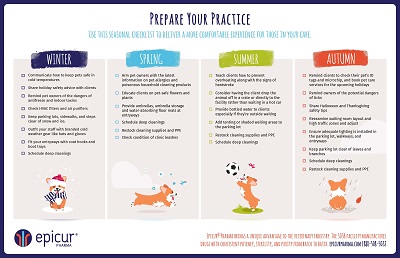The following blog is written by Epicur Pharma’s Advisory Council member Nicole Clausen, CSSGB, CCFP. Nicole is also the founder of Veterinary Care Logistics and Veterinary Inventory Strategy Network. Below, she shares her perspective and insights on sustainable, efficient inventory management strategies for veterinary practices.
From Nicole:
Veterinary professionals, your mission is clear: Provide top-notch care for our four-legged friends. You may not know it, but efficient inventory management is the behind-the-scenes star that ensures you can deliver the best care possible.
In this blog post, we’ll take a deeper look at the essentials of inventory management tailored specifically for veterinary practices—demand forecasting, the importance of streamlined systems and workflows, organization tips, and finding the perfect balance between practice needs and patient care. Let’s dive in!
Demand Forecasting: The Crystal Ball of Inventory Management
Demand forecasting is the cornerstone of efficient inventory management. It’s like predicting the future needs of your practice so you can stock up on the right supplies at the right time. Here’s how to go about it:
Historical Data: Start by digging into your practice’s history. Analyze information from your practice management system, past caseloads, your purchase history, and the corresponding medical supplies, medications, and equipment required.
Seasonal Variations: Consider the seasons, as they often bring different health concerns. For instance, flea and tick prevention may be in high demand during the spring and summer. Practices in a warmer, more humid climate might see an uptick in allergies and use more dermatology products in the springtime.
Download:
(It makes a great print-out for your practice!)
Industry Trends: Stay up to date with industry trends, supply chain disruptions, and emerging treatments. New medications or procedures may impact your inventory requirements.
Collaborative Efforts: As your practice grows and changes, it’s likely your inventory demand will as well. If veterinarians are joining or leaving your team, it’s recommended to review your sales to see if any updates should be made.
The Importance of Systems and Workflows
Now that you’ve nailed demand forecasting, let’s talk about systems and workflows. These are the gears that make the inventory management machine run smoothly:
Leverage Your Practice Management System: Your practice management system or veterinary-specific inventory management software can be a treasure trove of information and offer several tools to help manage your inventory. These tools are tailored to your needs, helping you track stock levels, reorder points, and expiration dates with ease.
Haven’t made the switch to digital tools in your practice?
Download our inventory management guide for 7 best practices that increase ROI.
Centralized Storage: Organize your inventory in one central location that’s accessible to the entire team. Clearly label shelves and containers to minimize confusion. If you don’t have space in your practice for centralized storage, try to develop “inventory zones” to maximize efficiency.
FIFO and FEFO: Implement the FIFO (First-In-First-Out) and FEFO (First-Expiry-First-Out) methods to ensure that older inventory is used first, reducing the risk of expiration. If receiving and unpacking boxes are delegated to different team members, ensure they understand how to restock products properly to help avoid expired items.
Experiencing shortened beyond-use dates on compounded medication?
Explore the new USP guidelines and what it means for your veterinary practice.
Regular Audits: Schedule routine inventory audits and cycle counts to catch discrepancies early. This practice keeps shortages and overstocking at bay. In addition, it can also help you uncover theft, instances of missed charges, and waste.
Organizing Tips: Keep Clutter at Paw’s Length
Organization is the key to sanity in inventory management. Try these tips to maintain a tidy inventory:
Categorization: Group similar items together, creating sections for medications, surgical supplies, diagnostics, and more. It’s also helpful to put the most frequently used items at eye-level and place less frequently used items on the top or bottom shelves.
Label Everything: Clearly label each item with its name, vendor item code, and any reorder points or minimum and maximum levels. Use color coding to streamline identification. This helps your team (and you) find precisely what they need when they need it.
Avoid Overstocking: While preparedness is vital, avoid overstocking to prevent excess stock, high inventory costs, and clutter, and ensure resources are used efficiently. Overstocking can negatively impact the practice’s financial performance, so it’s important to find the balance between too much and not enough.
Set Up Alerts: Configure your practice management system or other software to notify you when stock levels reach the reorder point, ensuring you never run out of essentials. You can also use shelf labels, reorder tags, or other methods to help set up flags for when hospital supplies and consumables are running low.
Balancing Practice Needs with Patient Care
Finding the sweet spot between your practice’s needs and your patients’ well-being is an art. Here’s how to master it:
Prioritize Patient Care: Your patients’ health is paramount. Always ensure you have an adequate supply of essential medications and equipment for immediate care.
Review Financial Information: Managing inventory costs is vital for your practice’s financial health. Analyze your spending, inventory key performance indicators, and other analytics for inventory purchases smartly.
Stay stocked for critical moments.
Partnering with an FDA-registered 503B outsourcing facility like Epicur means you can safely order and stock our medications for hospital and office administration.
Forge Vendor Relationships: Building strong relationships with distributors and suppliers can be a win-win. Timely payments and good communication often lead to better terms and even discounts.
Emergency Preparedness: Have a contingency plan for unexpected spikes in demand or supply chain disruptions. Consider having a process and game plan for when the inevitable backorders happen.
Effective inventory management is the unsung hero of veterinary practices and is vital to not only practice management but ensures you provide the highest level of care to your furry, scaly, and slithery patients. By mastering the essentials of demand forecasting, streamlined systems and workflows, organization, and practice/patient balance, you’ll create a harmonious and efficient environment. So go ahead, embrace efficient inventory management and let your practice thrive, one paw print at a time!







